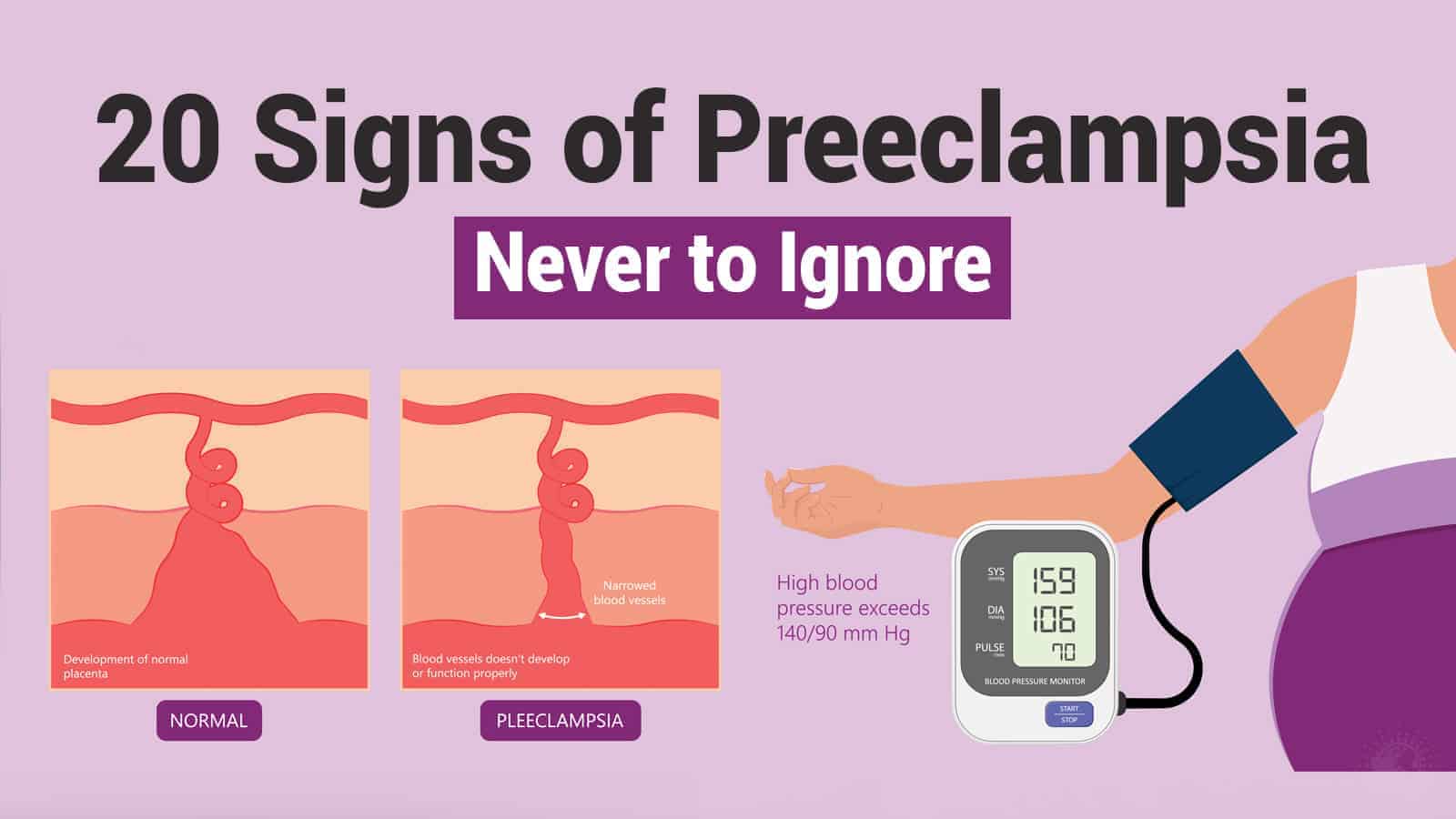There’s nothing more exciting than finding out you’re expecting a child. However, your body goes through many changes, and it can be a confusing and even scary time. Conditions like preeclampsia and gestational diabetes can threaten the health and safety of both you and your child.
If this is your first pregnancy, you may not know what to expect, which will only add to the anxiety of the situation. However, certain red flags that your body will give you that indicate something is wrong, such as with conditions like pre-eclampsia.
Preeclampsia is a complication that arises during pregnancy. A study conducted by the Eunice Kennedy Shriver National Institute of Child Health and Human Development found that around 20-40 percent of women develop this situation each year. It’s imperative to treat this condition right away as it can be a serious, even fatal illness for both you and the baby.
What Causes This Pregnancy Complication?
 While this medical condition’s exact cause is unknown, there are many theories about why it develops. First, it’s suspected that the placenta doesn’t function properly, which causes complications to both the baby and the mother. It’s also thought to come from poor nutrition, such as a mother eating a diet full of high-fat foods and carbohydrates, which is often found in obese pregnancies.
While this medical condition’s exact cause is unknown, there are many theories about why it develops. First, it’s suspected that the placenta doesn’t function properly, which causes complications to both the baby and the mother. It’s also thought to come from poor nutrition, such as a mother eating a diet full of high-fat foods and carbohydrates, which is often found in obese pregnancies.
Additionally, the blood flow to the placenta may be inadequate, as some blood vessels poorly develop. Lastly, immune function disorders are also known to contribute to issues during pregnancy, specifically pre-eclampsia.
Understanding Preeclampsia
This disorder is identified by hypertension and significant protein amounts found in the urine of a pregnant mother. Due to its prevalence, doctors routinely screen for this condition. It’s typically discovered at around 20-32 weeks during the pregnancy, but it can arise at other periods too.
Oddly enough, the sooner the condition is discovered, the greater the severity of the issue. Mothers who are diagnosed at 20 weeks carry higher risks than those diagnosed later. In the more severe cases, the red blood cells will begin to break down, and there will be a low platelet count, which can affect the function of vital organs.
Pre-eclampsia is so dangerous because it increases the risks of the expectant mother having seizures or organ failure. The only way to resolve this issue is to deliver the child, but that’s not possible when found early in the pregnancy.
Could there be a discrepancy of angiogenic factors within the placenta that causes this horrible condition? During pregnancy, new blood vessels are constantly forming as the baby’s need for vital nutrients increases. These vessels will replace the old ones to allow for biological function and development, called angiogenesis.
The Danger to Baby
Having an insufficient blood flow can cause problems for the fetus, including the lack of oxygen. A fetus delivered between 20-26 weeks gestation is considered a “micro-preemie.” Even with advanced medical care, the complications are significant, and the chances of survival are minimal.
The goal is to lower the blood pressure safely to prevent complications. There are many ways that this can be done naturally, such as using magnesium sulfate. Sadly, putting the mother on bed rest and changing her diet to lower her salt intake has shown minimal changes to the condition.
This ailment falls under the category of hypertensive disorders of pregnancy. Sadly, it’s one of the most common reasons for death for both the mother and baby during childbirth. Those women who suffer from this condition have an elevated risk of developing complications later in life, such as a stroke or heart disease.
Twenty Signs of Pre-eclampsia
The symptoms that you’ve developed pre-eclampsia include the following 20 things:
- Quick weight gain triggered by a substantial rise of bodily fluids
- Lower back pain
- Intestinal discomfort
- Terrible headaches
- Shifts in reflex response
- Racing Pulse
- Lightheadedness
- Extreme vomiting and nausea
- Changes in your vision, blurriness
- Puffiness of your hands and feet
- Reduced urine output
- Shoulder pain
- Compromised liver function
- Fluid in the lungs
- Breathing complications
- Hyperreflexia
- Anxiety
- Proteinuria or protein in the urine
- Discoloration of your legs from edema
- Mental confusion
Keep in mind that you may not have all these symptoms. You may develop a couple. However, when you’re an expectant mother, any changes that could indicate a condition like eclampsia or gestational diabetes, among others, should be evaluated.
To make a diagnosis, a doctor only needs to verify an increase in blood pressure and an imbalance of protein in the urine. In many cases, a mother can have this issue and have no symptoms, making it more dangerous. Proper medical care while expecting a child is of the utmost importance, especially when you consider things like this to go undetected.
The Role of Genetics
There is a certain lack of knowledge surrounding this condition, yet there are strong indicators that there are genetic factors in developing this ailment. A study was conducted in 2005 in Norway to see how genetics played a role in developing this issue.
According to The BMJ, who reported the medical research, the findings were astounding. They discovered that someone born to a mother who developed preeclampsia was more than two times more likely to develop it in their pregnancies.
Another shocking finding was that when the father had this condition in the womb, their offspring increased the risk of developing it. Using this data, both a history of this ailment from the mother and father in utero put the pregnancy at risk.
Risk Factors for Preeclampsia
Many risk factors indicate the increased probability that a mother will develop this condition. These risk factors include:

Researchers reveal a link between mothers who took acetaminophen during pregnancy and childhood issues.
• Kidney Disease
Since the kidneys filter the toxins from the body, a mother whose system is already compromised is at an increased risk. Her system is under even more stress when pregnant, which puts the kidneys under more strain.
• Hypertension
When a mother already has hypertension before she gets pregnant, it only increases the chances of this condition developing. The blood pressure may rise to uncontrollable levels, which can cause seizures and other serious complications.
• Diabetes
Diabetes is a disease where the body either doesn’t make enough insulin or is resistant to its insulin. When a pregnant mother has diabetes, it puts her at a higher risk of developing complications, such as preeclampsia.
• Advanced Maternal Age
Carrying a child when you’re over the age of 35 comes with increased risks. This advanced maternal age is often one of the factors doctors consider in the development of this situation.
• Multiple Gestation
When a mother carries more than one child, the blood flow may not be adequate for these children. Doctors often observe this condition when multiple babies share a womb, as it tends to be more common.
• Placenta Abnormalities
When there are issues with the placenta, such as placental ischemia, it puts the mother at an elevated risk. The placenta is responsible for delivering nutrients through blood flow to the child.
• Obesity
Being overweight and carrying a child already comes with an increased risk of complications, but the chances of developing preeclampsia are heightened. Obese mothers are also at risk of developing gestational diabetes and having low-weight babies born too early.
• Hypothyroidism
The thyroid controls many functions within the body. When these vital hormones are out of whack, it becomes a contributing factor to this disorder.
• Previous Kidney Donation
Donating a kidney is a generous act from one human being to another. However, during pregnancy, the lack of a robust filtering system can put the mother at advanced risk.
Making A Diagnosis
There’re no fancy lab tests needed to diagnose preeclampsia. The diagnostic criteria state that a mother must have an elevated blood pressure of greater than 140 mmHg systolic or 90 mmHg diastolic. The BP readings must have previously been normal, and physicians need two high readings within six hours.
Doctors will also look for proteinuria or an increase of protein in the urine. They usually do a 24-hour sample, and they look for levels that exceed 300 mg of protein.
 Final Thoughts on Knowing the Risk Factors and Signs of Preeclampsia
Final Thoughts on Knowing the Risk Factors and Signs of Preeclampsia
For the fetus born to a mother with this condition, it can spell trouble. The fetus might face growth restrictions due to the lack of blood flow and the risk of being born premature or dying in birth. It’s essential for a pregnant mother to monitor her blood pressure both in and outside the doctor’s office.
If a mother is at an elevated risk of developing this condition, then she should be cautious about monitoring both her BP as well as her blood sugar levels. Once this medical issue begins, the only way to resolve it is to deliver the baby, but this is not always possible. Depending on the age of the fetus, life may not be sustainable outside the womb.
Thankfully, things like magnesium sulfate have shown to be an effective and safe way to lower blood pressure for mothers who have preeclampsia.

















